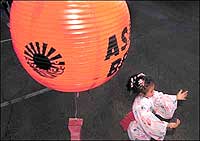Festival
celebrates living
Obon service, dance unites community
Marysville -- Inside the walls of the
Buddhist Church in Marysville Saturday, more than 150 people gathered to remember and
appreciate their loved ones who have passed on and to self-reflect during the ancient
Japanese Buddhist festival, the Obon.
 |
| Kelsey Koga, 6, of Yuba
City dances beneath a lantern at the annual Obon Festival at the Buddhist Church of
Marysville Saturday. |
|
|
Candles were lit, fresh flowers adorned the area of the alter and
the smell of burning incense wafted in the air as the congregation chanted. A small statue
of the Amida Buddha, a representation of eternal life, infinite light, and immeasurable
wisdom, was the center of the church's alter. "It is not a festival so much about the
dead, as it is about the festival of life and living itself," said Rev. Bryan
Siebuhr, the church's new resident minister. |
The Obon Festival,
also referred to as the Gathering of Joy, began with a memorial service held to remember
those that have passed away in the last year.
"It's a time
when they come to reflect upon their loved one's life and all the things the loved one has
given to them, the ways in which the loved one has contributed to their lives and express
that in their heart to the memory of the loved one and to Amid Buddha," said Siebuhr
in an interview Saturday.
Another service was
held to remember those who have passed away during the months of July and August in any
year.
Members lined up to
give monetary offerings to the temple in tribute to the deceased .
For 57-year-old
Caroline McEssy, who was raised in Yuba City but now lives in Citrus Heights, the service
helped her to better understand the meaning of Obon. McEssy, who lost her mother to cancer
in January, said the service brought her comfort.
"After all the
hardships she went through, it makes me feel that she's okay," McEssy said.
"It's just telling me that she's up there and fine," she said.
The tradition of
the Obon Festival began in the seventh century and revolves around a story about a
disciple named Mokkenren, Rev. Siebuhr said.
Mokkenren was a
disciple of the Buddha who had the ability to see into other spiritual realms. After his
mother died, Mokkenren expected his mother to be in the highest realm since his mother was
so nice to him and sacrificed so much, Siebuhr said. He finally finds her in the realm of
the Hungry Ghosts, where she is suffering from starvation.
Mokkenren asked
Buddha for guidance, and Buddha told him to bring an offering of food to the community of
monks at the end of their summer retreat and his mother would be reborn in the heavenly
realm. Mokkenren did just that and later found that not only his mother, but seven
generations of ancestors, had been reborn into the highest realm.
Mokkenren clapped
his hands and jumped for joy at the sight.
"This is the
story of the Obon dance," Rev. Siebuhr said.
Rev. Siebuhr said
that because Mokkenren's mother thought only of her son and not of the benefit of others,
her spirit went in a lower realm.
Siebuhr said the
consequences of one's life is based on the words and deeds of an individual's lifetime,
and where one is reborn is due to the good and evil one commits in his life.
After people
enjoyed a teriyaki chicken dinner, the dancing festivities began.
Seven graceful
dancers with fans took center stage as about 70 people, dressed in kimonos and hapi coats,
formed a circle and danced around them.
Gerald Uyeda of
Yuba City was there to watch his wife and his 7-year-old daughter, Kiomi, dance in the
circle.
"(Kiomi) was 3
when we first came (to the Obon festival)," Uyeda said. "She just kind of walked
around. It wasn't until this year that she began to understand the steps and the meaning
of the dances."
Uyeda said that he
thought the Obon Festival was beginning to have a resurgence, after the Japanese community
dwindled as children grew up and moved away.
"If you look
at the crowd, it's quite mixed now, which I think is good," Uyeda said. "It's a
chance for people to learn a little bit about the Japanese culture."
After the dancing,
six members of the Marysville YBA Taiko Group performed.
"We often refer to
(the Taiko drum) as the voice of Buddha," Siebuhr said. "When the Taiko drum is
struck, everybody, regardless of social or economic status, regardless of race and
education, the sound of the drum falls upon all ears equally, just as the Buddha embraces
all people equally and without any discrimination whatsoever," he said.